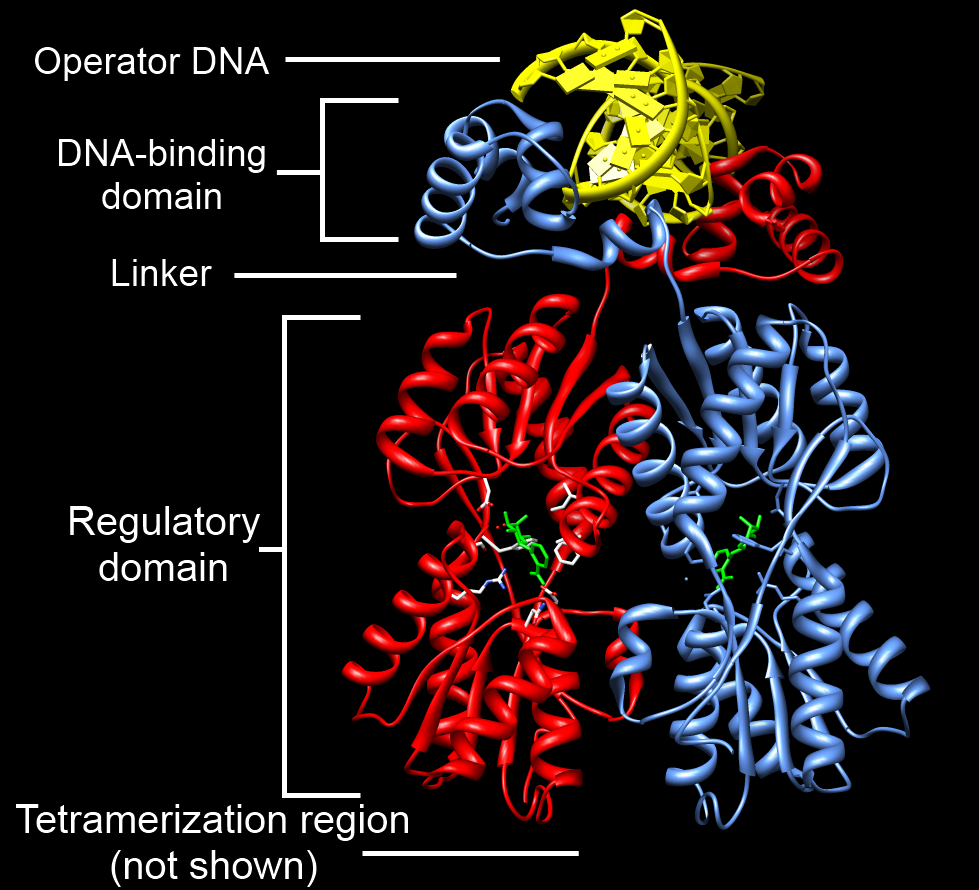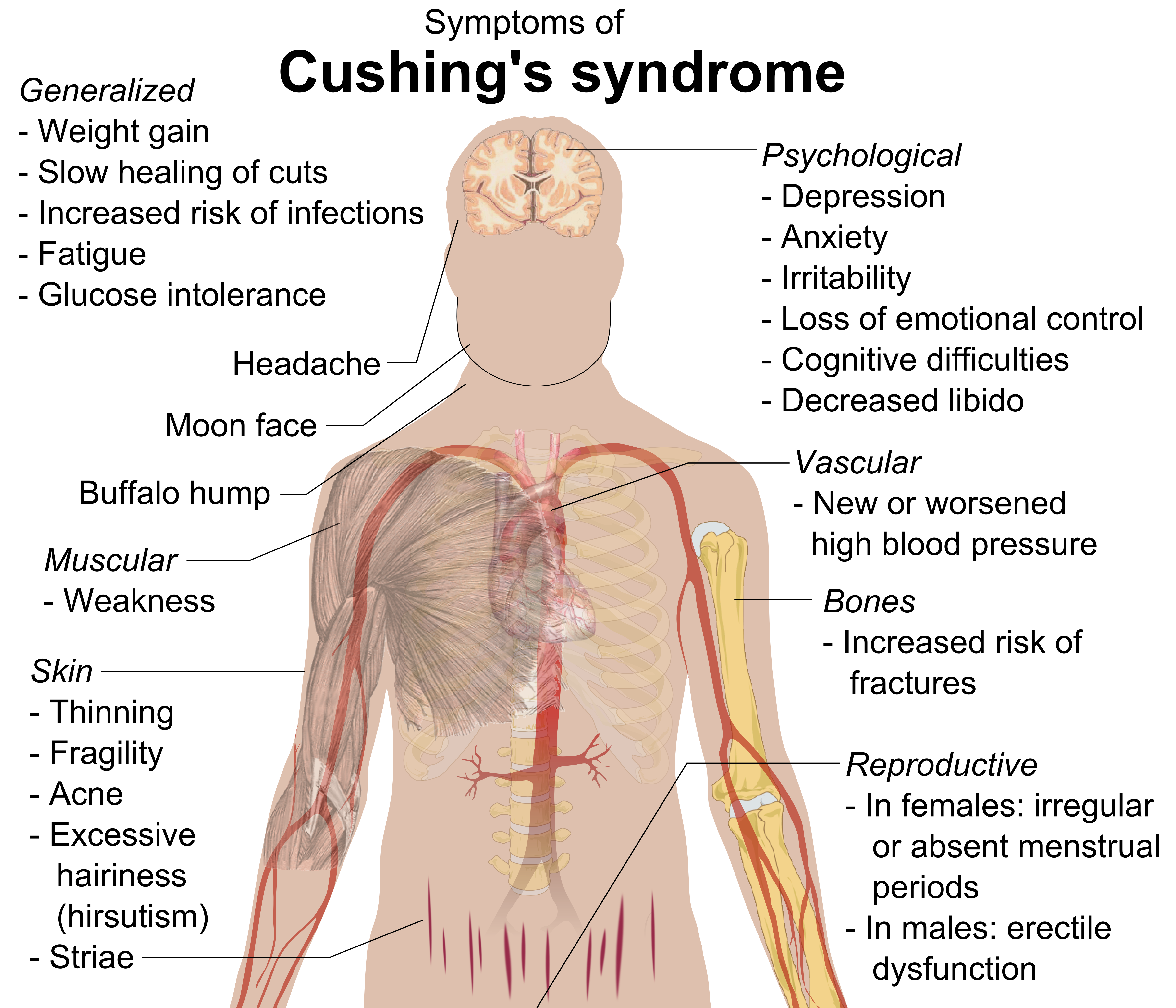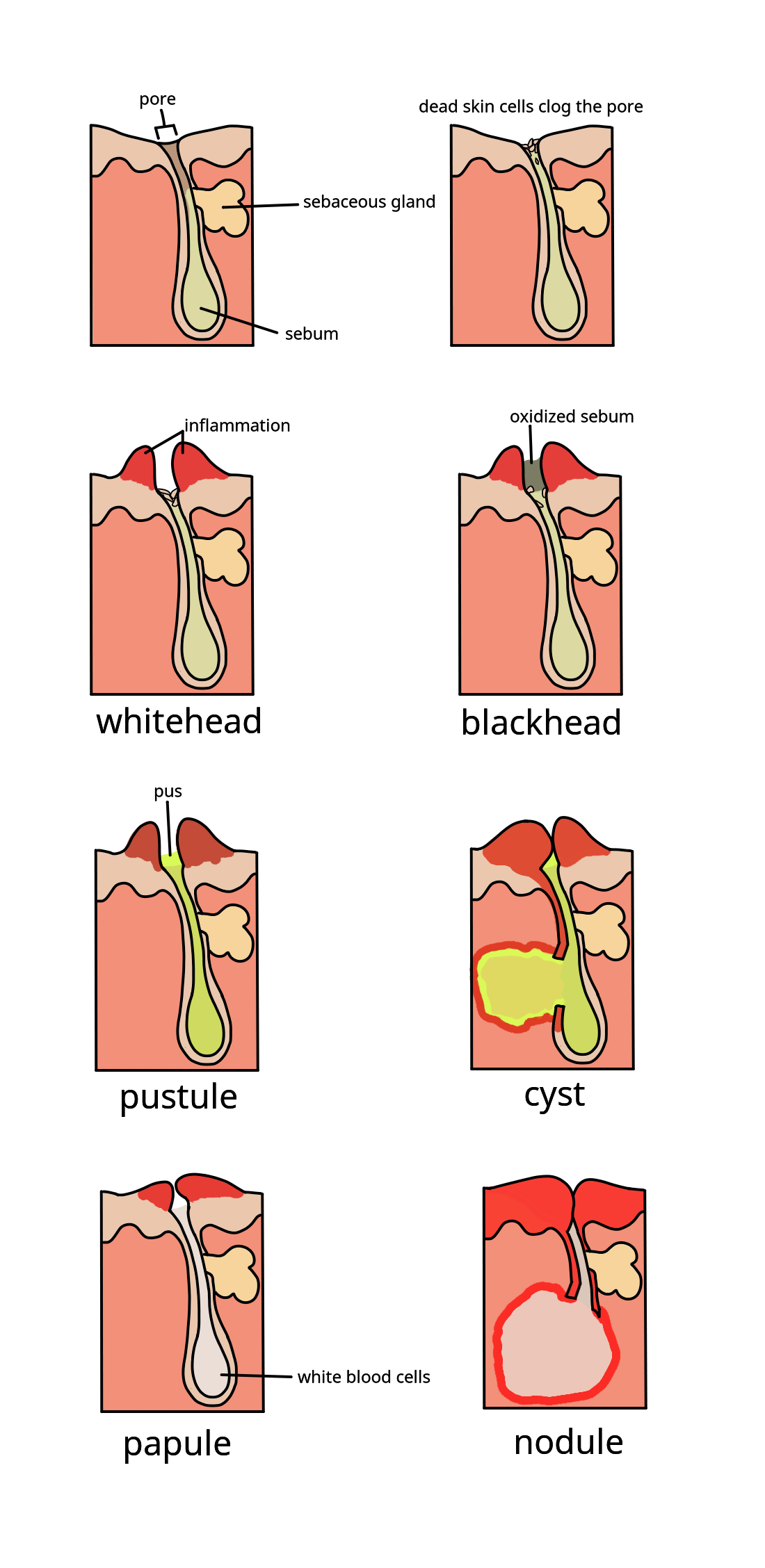|
Glucocorticoid Resistance
Generalized glucocorticoid resistance or Chrousos syndrome is a rare genetic disorder that can run in families or be sporadic. It is characterized by partial or generalized target-tissue insensitivity to glucocorticoids. The clinical spectrum includes severe, potentially fatal conditions like hypoglycemia, alkalosis, or severe hypokalemia, as well as completely asymptomatic forms. The disease's most prevalent symptom is fatigue. The elevated 24-hour urinary free cortisol (UFC) excretion in the absence of clinical signs of hypercortisolism and the elevated serum cortisol concentrations point to the diagnosis of generalized glucocorticoid resistance. The goal of treatment for generalized glucocorticoid resistance is to reduce excessive ACTH secretion, which in turn reduces the production of more adrenal steroids that have androgenic and mineralocorticoid properties. High dosages of synthetic glucocorticoids that spare mineralocorticoids, like dexamethasone, are used a ... [...More Info...] [...Related Items...] OR: [Wikipedia] [Google] [Baidu] |
DNA-binding Domain
A DNA-binding domain (DBD) is an independently folded protein domain that contains at least one structural motif that recognizes double- or single-stranded DNA. A DBD can recognize a specific DNA sequence (a recognition sequence) or have a general affinity to DNA. Some DNA-binding domains may also include nucleic acids in their folded structure. Function One or more DNA-binding domains are often part of a larger protein consisting of further protein domains with differing function. The extra domains often regulate the activity of the DNA-binding domain. The function of DNA binding is either structural or involves transcription regulation, with the two roles sometimes overlapping. DNA-binding domains with functions involving DNA structure have biological roles in DNA replication, repair, storage, and modification, such as methylation. Many proteins involved in the regulation of gene expression contain DNA-binding domains. For example, proteins that regulate transcription by ... [...More Info...] [...Related Items...] OR: [Wikipedia] [Google] [Baidu] |
Cushing's Syndrome
Cushing's syndrome is a collection of signs and symptoms due to prolonged exposure to glucocorticoids such as cortisol. Signs and symptoms may include high blood pressure, abdominal obesity but with thin arms and legs, reddish stretch marks, a round red face, a fat lump between the shoulders, weak muscles, weak bones, acne, and fragile skin that heals poorly. Women may have more hair and irregular menstruation. Occasionally there may be changes in mood, headaches, and a chronic feeling of tiredness. Cushing's syndrome is caused by either excessive cortisol-like medication, such as prednisone, or a tumor that either produces or results in the production of excessive cortisol by the adrenal glands. Cases due to a pituitary adenoma are known as Cushing's disease, which is the second most common cause of Cushing's syndrome after medication. A number of other tumors, often referred to as ectopic due to their placement outside the pituitary, may also cause Cushing's. Some of ... [...More Info...] [...Related Items...] OR: [Wikipedia] [Google] [Baidu] |
Growth Hormone Deficiency
Growth hormone deficiency (GHD), or human growth hormone deficiency, is a medical condition resulting from not enough growth hormone (GH). Generally the most noticeable symptom is that an individual attains a short height. Newborns may also present low blood sugar or a small penis size. In adults there may be decreased muscle mass, high cholesterol levels, or poor bone density. GHD can be present at birth or develop later in life. Causes may include genetics, trauma, infections, tumors, or radiation therapy. Genes that may be involved include GH1, GHRHR, or BTK. In a third of cases no cause is apparent. The underlying mechanism generally involves problems with the pituitary gland. Some cases are associated with a lack of other pituitary hormones, in which case it is known as combined pituitary hormone deficiency. Diagnosis involves blood tests to measure growth hormone levels. Treatment is by growth hormone replacement using synthetic human growth hormone. The frequency ... [...More Info...] [...Related Items...] OR: [Wikipedia] [Google] [Baidu] |
Glucocorticoid Deficiency
Adrenal insufficiency is a condition in which the adrenal glands do not produce adequate amounts of steroid hormones. The adrenal gland normally secretes glucocorticoids (primarily cortisol), mineralocorticoids (primarily aldosterone), and androgens. These hormones are important in regulating blood pressure, electrolytes, and metabolism as a whole. Deficiency of these hormones leads to symptoms ranging from abdominal pain, vomiting, muscle weakness and fatigue, low blood pressure, depression, mood and personality changes (in mild cases) to organ failure and shock (in severe cases). An adrenal crisis may occur if the body is subjected to stress, such as an accident, injury, surgery, or severe infection; this is a life-threatening medical condition resulting from severe deficiency of cortisol in the body. Death may quickly follow. Adrenal insufficiency can be caused by dysfunction of the adrenal gland itself, whether by destruction (e.g. Addison's disease), failure of development (e ... [...More Info...] [...Related Items...] OR: [Wikipedia] [Google] [Baidu] |
46,XX
A karyotype is the general appearance of the complete set of metaphase chromosomes in the cells of a species or in an individual organism, mainly including their sizes, numbers, and shapes. Karyotyping is the process by which a karyotype is discerned by determining the chromosome complement of an individual, including the number of chromosomes and any abnormalities. A karyogram or idiogram is a graphical depiction of a karyotype, wherein chromosomes are organized in pairs, ordered by size and position of centromere for chromosomes of the same size. Karyotyping generally combines light microscopy and photography, and results in a photomicrographic (or simply micrographic) karyogram. In contrast, a schematic karyogram is a designed graphic representation of a karyotype. In schematic karyograms, just one of the sister chromatids of each chromosome is generally shown for brevity, and in reality they are generally so close together that they look as one on photomicrographs as well u ... [...More Info...] [...Related Items...] OR: [Wikipedia] [Google] [Baidu] |
Ambiguous Genitalia
Intersex people are individuals born with any of several sex characteristics including chromosome patterns, gonads, or genitals that, according to the Office of the United Nations High Commissioner for Human Rights, "do not fit typical binary notions of male or female bodies". Sex assignment at birth usually aligns with a child's anatomical sex and phenotype. The number of births with ambiguous genitals is in the range of 1:2000–1:4500 (0.022%–0.05%). Other conditions involve atypical chromosomes, gonads, or hormones. Some persons may be assigned and raised as a girl or boy but then identify with another gender later in life, while most continue to identify with their assigned sex. The number of births where the baby is intersex has been reported differently depending on who reports and which definition of intersex is used. Anne Fausto-Sterling and her co-authors suggest that the prevalence of "nondimorphic sexual development" might be as high as 1.7%. A study publish ... [...More Info...] [...Related Items...] OR: [Wikipedia] [Google] [Baidu] |
Hirsutism
Hirsutism is excessive body hair on parts of the body where hair is normally absent or minimal. The word is from early 17th century: from Latin ''hirsutus'' meaning "hairy". It usually refers to a "male" pattern of hair growth in a female that may be a sign of a more serious medical condition, especially if it develops well after puberty. Cultural stigma against hirsutism can cause much psychological distress and social difficulty. Discrimination based on facial hirsutism often leads to the avoidance of social situations and to symptoms of anxiety and depression. Hirsutism is usually the result of an underlying endocrine imbalance, which may be adrenal, ovarian, or central. It can be caused by increased levels of androgen hormones. The amount and location of the hair is measured by a Ferriman-Gallwey score. It is different from hypertrichosis, which is excessive hair growth anywhere on the body. Treatments may include certain birth control pills, antiandrogens, or insulin ... [...More Info...] [...Related Items...] OR: [Wikipedia] [Google] [Baidu] |
Acne
Acne, also known as ''acne vulgaris'', is a long-term Cutaneous condition, skin condition that occurs when Keratinocyte, dead skin cells and Sebum, oil from the skin clog hair follicles. Typical features of the condition include comedo, blackheads or whiteheads, pimples, oily skin, and possible scarring. It primarily affects skin with a relatively high number of sebaceous gland, oil glands, including the face, upper part of the chest, and back. The resulting appearance can lead to anxiety (mood), anxiety, reduced self-esteem, and, in extreme cases, clinical depression, depression or suicidal ideations, thoughts of suicide. Susceptibility to acne is primarily genetic in 80% of cases. The roles of diet and cigarette smoking in the condition are unclear, and neither hygiene, cleanliness nor exposure to sunlight appear to play a part. In both sexes, hormones called androgens appear to be part of the underlying mechanism, by causing increased production of sebum. Another common fac ... [...More Info...] [...Related Items...] OR: [Wikipedia] [Google] [Baidu] |
Male-pattern Hair Loss
Pattern hair loss (also known as androgenetic alopecia (AGA)) is a hair loss condition that primarily affects the top and front of the scalp. In male-pattern hair loss (MPHL), the hair loss typically presents itself as either a receding front hairline, loss of hair on the crown (vertex) of the scalp, or a combination of both. Female-pattern hair loss (FPHL) typically presents as a diffuse thinning of the hair across the entire scalp. Male pattern hair loss seems to be due to a combination of oxidative stress, the microbiome of the scalp, genetics, and circulating androgens; particularly dihydrotestosterone (DHT). Men with early onset androgenic alopecia (before the age of 35) have been deemed as the male phenotypic equivalent for polycystic ovary syndrome (PCOS). As an early clinical expression of insulin resistance and metabolic syndrome, AGA is related to being an increased risk factor for cardiovascular diseases, glucose metabolism disorders, type 2 diabetes, and enlargement ... [...More Info...] [...Related Items...] OR: [Wikipedia] [Google] [Baidu] |
Precocious Puberty
In medicine, precocious puberty is puberty occurring at an unusually early age. In most cases, the process is normal in every aspect except the unusually early age and simply represents a variation of normal development. In a minority of children with precocious puberty, the early development is triggered by a disease such as a tumor or injury of the brain. Even when there is no disease, unusually early puberty can have adverse effects on social behavior and psychological development, can reduce adult height potential, and may shift some lifelong health risks. Central precocious puberty can be treated by suppressing the pituitary hormones that induce sex steroid production. The opposite condition is delayed puberty. The term is used with several slightly different meanings that are usually apparent from the context. In its broadest sense, and often simplified as early puberty, "precocious puberty" sometimes refers to any physical sex hormone effect, due to any cause, occurring ... [...More Info...] [...Related Items...] OR: [Wikipedia] [Google] [Baidu] |
Amenorrhea
Amenorrhea is the absence of a menstrual period in a woman of reproductive age. Physiological states of amenorrhoea are seen, most commonly, during pregnancy and lactation (breastfeeding). Outside the reproductive years, there is absence of menses during childhood and after menopause. Amenorrhoea is a symptom with many potential causes. Primary amenorrhea is defined as an absence of secondary sexual characteristics by age 13 with no menarche or normal secondary sexual characteristics but no menarche by 15 years of age. It may be caused by developmental problems, such as the congenital absence of the uterus, failure of the ovary to receive or maintain egg cells, or delay in pubertal development. Secondary amenorrhoea, ceasing of menstrual cycles after menarche, is defined as the absence of menses for three months in a woman with previously normal menstruation, or six months for women with a history of oligomenorrhoea. It is often caused by hormonal disturbances from the hypothalamu ... [...More Info...] [...Related Items...] OR: [Wikipedia] [Google] [Baidu] |
Oligospermia
Terms oligospermia, oligozoospermia, and low sperm count refer to semen with a low concentration of sperm and is a common finding in male infertility. Often semen with a decreased sperm concentration may also show significant abnormalities in sperm morphology and motility (technically oligoasthenoteratozoospermia). There has been interest in replacing the descriptive terms used in semen analysis with more quantitative information. Diagnosis The diagnosis of oligozoospermia is based on one low count in a semen analysis performed on two occasions. For many decades sperm concentrations of less than 20 million sperm/ml were considered low or oligospermic, recently, however, the WHO reassessed sperm criteria and established a lower reference point, less than 15 million sperm/ml, consistent with the 5th percentile for fertile men. Sperm concentrations fluctuate and oligospermia may be temporary or permanent. Sources usually classify oligospermia in 3 classes: *Mild: concentrations 10 mi ... [...More Info...] [...Related Items...] OR: [Wikipedia] [Google] [Baidu] |








